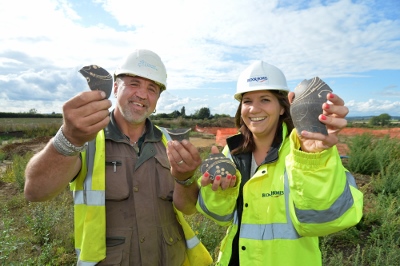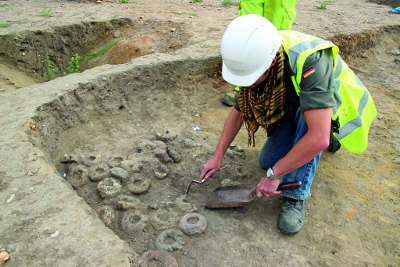6,000 years of Thame’s archaeological history
On 01/10/2015 At 5:29 pm
Category : Missed a ThameNews story?, More News, Thame news
Responses : No Comments
FOLLOWING our report of exciting archaeological finds during a recent ‘dig’ at the site of a new housing development, (SEE LINK), more information about the evidence of human activity dating back around 6,000 years uncovered there, has emerged.

Chris Ellis, Senior Project Officer at Cotswold Archaeology, and Gemma Deacon, Sales Manager for Bloor Homes South Midlands, with some of the finds discovered during an excavation of the Thame Meadows site
The remains of prehistoric monuments and settlements going back to the Neolithic period were among the exciting discoveries made during a seven month excavation of Bloor Homes’ Thame Meadows site, in Oxford Road. Archaeologists have described the dig, which was carried out by experts from Oxford Cotswold Archaeology, as one of the most significant undertaken in Britain this year, and one that ‘far surpassed’ their expectations.
Rare monument found
One of the most important finds was the discovery of a rare causewayed enclosure dating back to around 3,700BC, one of only 80 such monuments known to exist in Britain. Consisting of one or more circuits of bank and ditch, they are the earliest known monuments made by some of the earliest farming communities and were constructed to enclose areas of open space where communal gatherings to conduct such things as rictuals would take place.
Chris Ellis, Senior Project Officer at Cotswold Archaeology, part of a joint venture with Oxford Archaeology, said: “We have come across an amazing mass of archaeology from 6,000 years of human history, all on this one site. For the sheer density and range of archaeological features and the long period which they span, this has been the most fascinating and exhilarating excavation I have been involved with in my 25-year career.
“To encounter this amount of archaeology on just one development site is almost unheard of, and the discoveries have sparked a great deal of interest among academics. It’s one of the most significant digs to have taken place in Britain this year. Particularly, the discovery of a ‘new’ enclosure in British archaeology is extremely rare, so to discover such extensive remains of one on a relatively small project like this is extremely exciting.”
Human remains
Archaeologists also uncovered the remains of at least three roundhouses from the early Iron Age period (700-400BC), and more than 150 pits, used for storing grain and later disposing of rubbish, some containing human remains where settlers had buried the dead.
Discoveries from the Roman period (AD43-410) include a number of enclosures which housed corn drying ovens, while around 14 small Saxon buildings, dating from the 6th to 7th Century AD and believed to have been textile workshops, were also uncovered. Flint tools, pottery and combs made from animal bone were just some of the thousands of artefacts discovered. 
Chris explained that the site possessed several attributes which had made it an attractive location for settlers through the ages. He said: “People settled here because of the well-drained sandy geology, its prominent position in the landscape and its fantastic vistas to the north and south.”
The finds from the excavation will be housed with the Oxfordshire County Museum Service, and it is likely some of the objects will be displayed in Thame Museum.
Gemma Deacon, Sales Manager for Bloor Homes South Midlands, said: “It’s been absolutely fascinating to see the wide variety of items uncovered by archaeologists during the dig. It really is amazing to think that the site contained objects spanning almost 6,000 years of human history. The site has clearly been a popular location for human settlers throughout the ages and we believe our Thame Meadows development will prove just as attractive to house hunters looking for their perfect home in the Oxfordshire countryside.”
The Thame Meadows site is around 9.4 hectares in size and is located to the north of Oxford Road, directly opposite Lord Williams’s School and now that the archaeological excavation is complete, Bloor is about to begin building 203 new homes on the land, the first first of which are set to be released for sale in the winter.
MORE images from the Thame ‘dig’ HERE



